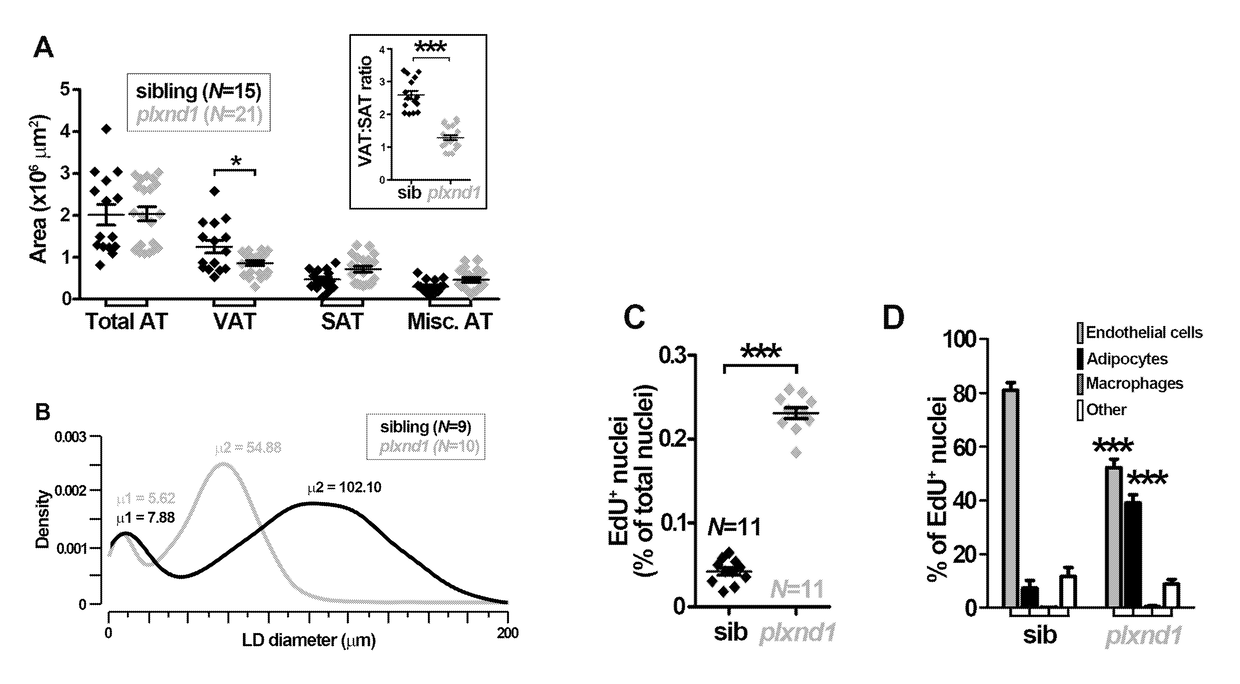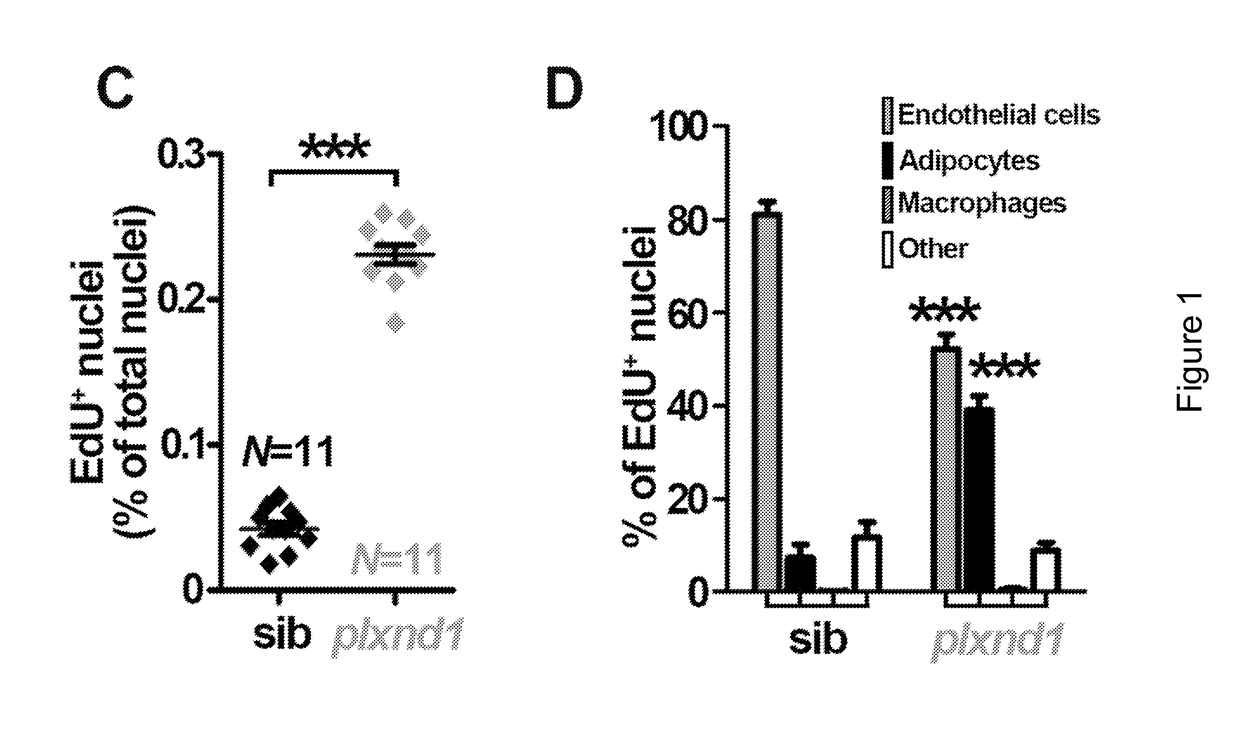Compositions and Methods for Identifying and Modulating Metabolic Health
a metabolic health and composition technology, applied in the field of compositions and methods for identifying and modulating metabolic health, can solve problems such as hypervascularization in many tissues
- Summary
- Abstract
- Description
- Claims
- Application Information
AI Technical Summary
Benefits of technology
Problems solved by technology
Method used
Image
Examples
example 1
Methods of Zebrafish plxnd1 Engineering and Analysis
[0106]Zebrafish husbandry and staging. To test the role of Plxnd1 in body fat distribution, Zebrafish were genetically engineered to disrupt the function of the Plxnd1 gene according to methods known to the art, described in the present disclosure, as well as methods and references incorporated herein. Zebrafish were raised, fed, and housed as described. (Westerfield M (2000) The Zebrafish Book-A guide for the laboratory use of zebrafish (Danio rerio). University of Oregon Press, Eugene, Oreg.; Flynn E J, et al. (2009), Journal of lipid research 50 (8):1641-1652; Imrie D & Sadler K C (2010), Developmental dynamics. 239 (11):3013-3023.) The plxnd1fov01b null mutation was maintained on transgenic Tg(fli1a:egfp)y1 (hereafter referred to as fli1a:EGFP) or Tg(kdrl:HsHRAS-mCherry)s896 (hereafter referred to as flk1:mcherry) on Ekkwill backgrounds. (Torres-Vazquez J, et al. (2004), Developmental cell 7 (1):117-123; Childs S, et al. (2002)...
example 2
PLXND1mRNA is Positively Associated with Hypertrophic Morphology in Human VAT, but not SAT
[0116]Human gene expression and morphology methods. Subjects were investigated in the morning after an overnight fast. To relate PLXND1 expression to AT morphology (FIG. 1F), VAT and SAT biopsies were taken from 79 obese women scheduled for gastric bypass surgery. Morphology in each adipose depot (hyperplastic / hypertrophic) was determined as described. (Hoffstedt J, et al. (2010), Diabetologia 53 (12):2496-2503.) Neither morphology, nor hypertrophic AT were dependent on BMI. mRNA was quantified in AT as described. (Ryden M, et al. (2007), American journal of physiology. Endocrinology and metabolism 292 (6):E1847-1855.) qRT-PCR was performed using pre-TaqMan kits for PLXND1 (HS 00391129_m1), and LRP10 (Hs01047362_m1) (Applied Biosystems). Expression of PLXND1 was normalized to the LRP10 internal control using the comparative Ct method. PLXND1 mRNA expression was found to be slightly higher in SA...
example 3
ECM Dynamics in PLXND1Mutant Zebrafish
[0118]Col5a1 is induced by vascular endothelial cells of plxnd1 mutant zebrafish VAT
[0119]qRT-PCR revealed large-scale dysregulation of ECM components within plxnd1 mutant VAT (FIG. 2A; see also Table 1 for qRT-PCR primers). A subset of ECM components were downregulated (FIG. 2A); however, the type V collagens col5a1and col5a3b were increased (FIG. 2A).
[0120]Immunofluorescence confirms an increase in Col5 protein and reveals specific localization to vascular endothelial cells in plxnd1 mutant VAT (FIGS. 2B& C). FACS enrichment of endothelial cells followed by qRT-PCR shows that col5a1 mRNA is increased in plxnd1 mutant endothelial cells (FIG. 2D), supporting a vascular endothelial cell origin for Col5a1 in plxnd1 mutant VAT.
[0121]Knockdown of Col5a1 normalizes hyperproliferation and hyperplastic morphology within plxnd1 mutant VAT
[0122]Zebrafish col5a1 was targeted with multiple, non-overlapping Vivo-Morpholinos (vMOs) (FIG. 9).
[0123]Zebrafish w...
PUM
| Property | Measurement | Unit |
|---|---|---|
| diameter | aaaaa | aaaaa |
| diameter | aaaaa | aaaaa |
| concentration | aaaaa | aaaaa |
Abstract
Description
Claims
Application Information
 Login to View More
Login to View More - R&D
- Intellectual Property
- Life Sciences
- Materials
- Tech Scout
- Unparalleled Data Quality
- Higher Quality Content
- 60% Fewer Hallucinations
Browse by: Latest US Patents, China's latest patents, Technical Efficacy Thesaurus, Application Domain, Technology Topic, Popular Technical Reports.
© 2025 PatSnap. All rights reserved.Legal|Privacy policy|Modern Slavery Act Transparency Statement|Sitemap|About US| Contact US: help@patsnap.com



